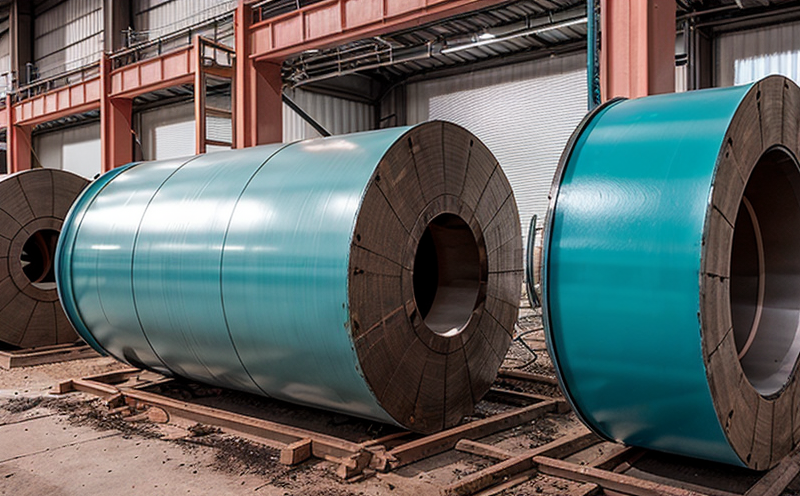ISO 7539-9 Crevice Corrosion Resistance Testing
The ISO 7539-9 standard provides a method for assessing the crevice corrosion resistance of materials used in industrial manufacturing and processing. Crevice corrosion is a localized form of pitting that occurs at points where two or more metal surfaces come into contact, forming a micro-environment with low oxygen concentration and high chloride content. This type of corrosion can lead to premature failure of components and structures, particularly in environments involving seawater, chlorides, or other aggressive solutions.
The test method described in ISO 7539-9 involves the following key steps:
- Preparation of specimens with crevices formed by clamping two metal plates together.
- Submersion of the specimen into a chloride-containing solution under controlled conditions (temperature, humidity).
- Observation and measurement of corrosion growth over time.
The test is crucial for industries such as chemical processing, oil & gas, pharmaceuticals, and marine engineering where materials must withstand harsh environments. The results provide critical insights into the performance of various alloys, coatings, and composite materials used in these sectors.
| Key Parameters | Description |
|---|---|
| Test Specimen Type | Closed-cell crevice geometry with a defined spacing between the metal plates. |
| Solution Composition | Phosphate buffer solution or sodium chloride aqueous solution, depending on the test condition. |
| Test Duration | Typically ranges from 14 to 28 days but can be extended based on material performance. |
| Metering Method | Visual inspection and measurement using a micrometer or digital caliper for corrosion depth. |
The test results are reported in terms of the average crevice corrosion rate (mm/year) or the percentage of specimens showing signs of crevice formation. These metrics help manufacturers choose materials that offer optimal resistance to crevice corrosion, thereby improving product reliability and longevity.
Understanding the parameters involved in this testing method is essential for quality managers and compliance officers who need to ensure their suppliers meet stringent standards. By incorporating ISO 7539-9 into their procurement specifications, they can guarantee that the materials used are robust against crevice corrosion, thus reducing maintenance costs and enhancing safety.
Eurolab Advantages
At Eurolab, we offer unparalleled expertise in ISO 7539-9 Crevice Corrosion Resistance Testing, leveraging our state-of-the-art facilities and experienced personnel to deliver accurate and reliable results. Our advantages include:
- Accurate Replication of Real-world Conditions: We simulate the exact environmental conditions that your materials will encounter in industrial applications.
- Dedicated Test Facilities: Our labs are equipped with specialized equipment to conduct this stringent test method, ensuring precision and repeatability.
- Comprehensive Reporting: Our reports include detailed data on corrosion rates, specimen integrity, and any other relevant findings, providing a clear picture of the materials’ performance.
- Expertise in Material Selection: Our team can provide recommendations based on test results to help you make informed decisions about material selection.
- Compliance with International Standards: We adhere strictly to ISO 7539-9 guidelines, ensuring that our tests are valid and credible.
- Timely Turnaround Times: We understand the importance of timely results in your project timeline. Our efficient processes ensure quick turnaround without compromising on quality.
- Custom Solutions: For unique testing requirements not covered by standard protocols, we can develop custom test methods tailored to your specific needs.
- Training and Consultation Services: We offer training sessions and consultation services to help you understand the nuances of this testing method and how it applies to your industry.
Partnering with Eurolab ensures that you have access to the highest quality testing services, delivered by experts who are committed to excellence in every project they undertake.
Customer Impact and Satisfaction
The impact of ISO 7539-9 Crevice Corrosion Resistance Testing on customer satisfaction cannot be overstated. By ensuring that the materials used in critical industrial processes are robust against crevice corrosion, we help our customers achieve several key benefits:
- Enhanced Product Reliability: Our testing ensures that the components and structures made from these materials will perform reliably over extended periods.
- Safety Assurance: By identifying potential weak points in designs early on, we help prevent failures that could lead to accidents or environmental damage.
- Cost Savings: With a reduction in maintenance costs due to longer-lasting components and fewer replacements, customers see significant financial benefits.
- Compliance with Regulations: Our tests ensure that the materials comply with relevant international standards like ISO 7539-9, providing peace of mind for regulatory compliance.
- Innovation Support: By offering cutting-edge testing methods and expert advice, we support our customers in developing new products and processes.
Our commitment to quality and excellence has earned us a reputation for delivering exceptional service. Customers trust Eurolab with their most critical materials testing needs because they know that we provide accurate, reliable results every time.
Use Cases and Application Examples
| Industry Sector | Description of Use Case |
|---|---|
| Chemical Processing | Evaluating the corrosion resistance of stainless steel tanks used in chloride-containing environments. |
| Oil & Gas | Assessing the integrity of pipeline fittings exposed to aggressive seawater conditions. |
| Pharmaceuticals | Determining the durability of metal containers for storing highly corrosive chemical reagents. |
| Marine Engineering | Testing the corrosion resistance of fasteners used in shipbuilding and repair. |
| Material Type | Description of Use Case |
|---|---|
| Stainless Steel Alloys | Identifying the most suitable grade for use in seawater cooling systems. |
| Copper-Based Alloys | Evaluating the performance of brass fittings exposed to chlorinated environments. |
| Aluminum Alloys | Determining the durability of aluminum components used in chemical processing equipment. |
The results from these tests play a crucial role in ensuring that materials perform reliably under specific conditions. For instance, stainless steel alloys like 316L and 304L have been shown to offer excellent resistance to crevice corrosion, making them ideal for use in chloride-containing environments.
Our testing facility provides the necessary infrastructure to conduct these tests accurately and consistently. By leveraging our expertise, you can ensure that your industrial processes are optimized for both performance and safety.





